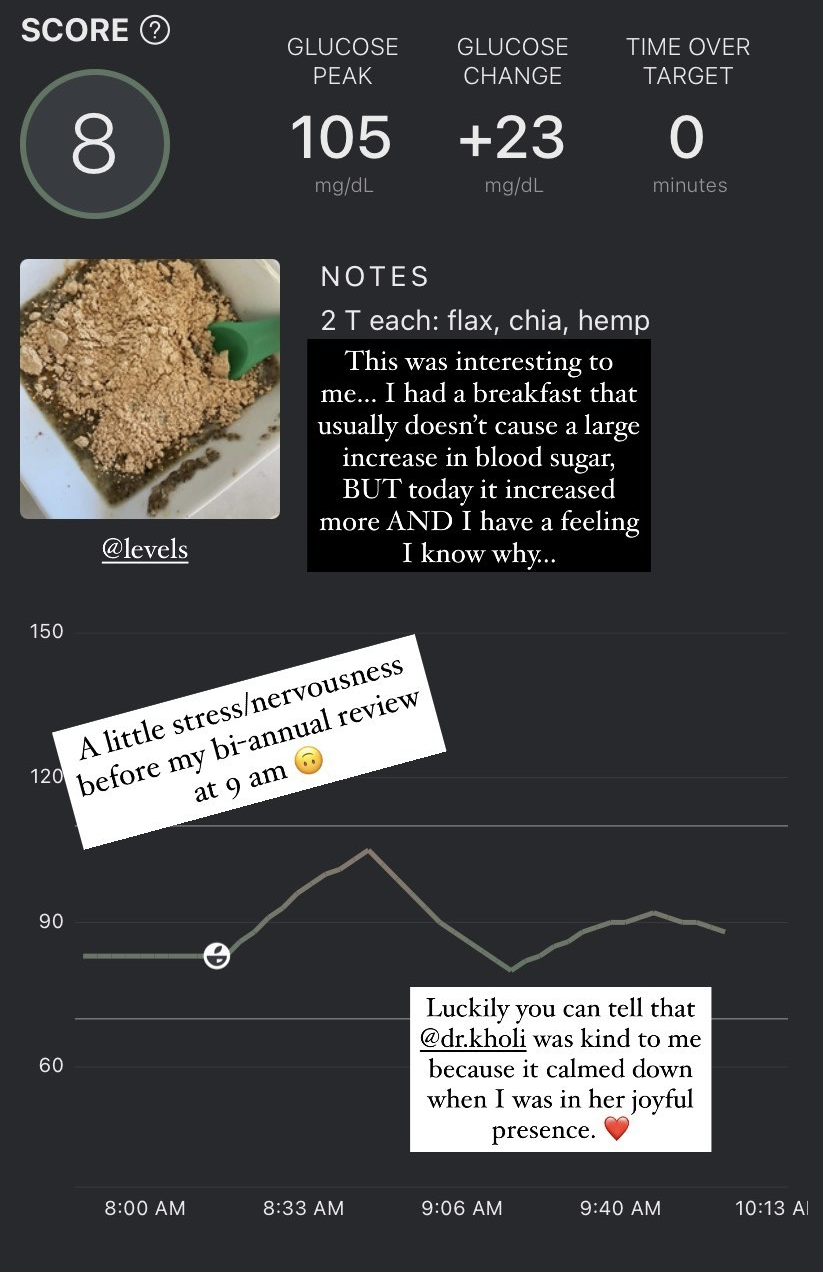Dietitian, trainer, and Whole30 advisor Stephanie Greunke is trying to bring metabolic awareness to clients that have a lot of other things on their mind: pregnant women with changing hormones and energy needs, and new moms just trying to figure out how to fit a bite of food and a wink of sleep into their new life with an infant.
So she offers practical advice that delivers tangible results. “I love to focus on metabolic health because it allows you to understand better what you feel is best for you, regardless of the specific diet,” Greunke says. Regardless of someone’s individual habits, she adds, optimizing blood sugar is usually a primary goal.
“‘Objective information helps you feel less like you’re the victim of anxiety and more in the driver’s seat.’”
That focus led her to try Levels, and she quickly appreciated the value of seeing real-time feedback tied to food choices.
“A continuous glucose monitor helps people better understand what’s going on in their bodies and adjust accordingly,” Greunke says. “For example, watch how different your responses are from a plain apple versus one paired with almond butter. Once you see the data, making better choices becomes a no-brainer.”
As a mom to two young boys herself, Greunke knows how much anxiety can come with parenting—especially newborns—and how much tracking your diet can help. “Objective information helps you feel less like you’re the victim of anxiety and more in the driver’s seat,” she says. “You can say to yourself, ‘Okay, I realize how much these fluctuations in my blood sugar are contributing to me feeling those symptoms that I identified as anxiety.”
Here, Greunke shares some of the tips and systems she gives her clients trying to fit metabolic health into a hectic life.
1. Shop by ingredients, not labels
As consumers, we have to be a little bit skeptical about the things that we choose to put in our bodies, which starts with being aware that what the label says doesn’t necessarily mean the food is better for you.
Labels aren’t very well-regulated and may not be completely reliable, as we’ve seen with terms like “net carbs.” (Let’s also not forget that there are more than 56 names for sugar, so even if the label doesn’t mention sugar, it still could be in there).
The parents that I work with can overspend on packaged products thinking they will make their health inherently better. Packaged products might make your life easier, and can add variety, but don’t get caught up in what labels claim as health benefits.
Instead, turn over the package and look at the ingredient list and nutrition facts, because that’s really where the gold is. You want to know exactly what ingredients are in it, and ask yourself: Is this something that I want to put in my body?
Unpackaged whole foods don’t have a label because they don’t need one. If they did have labels, they’d look much better than what packaged foods offer.
 2. Think about food in pairs
2. Think about food in pairs
Snacking smart isn’t something that comes intuitively. To most people, apples and granola bars seem like great healthy snacks. Others try to stay low calorie to lose weight.
But it isn’t just about the calories, it’s about having a metabolic response that will ultimately help with willpower and cravings later.
For example, you can add a bit of peanut butter or almond butter to that apple, and it might be a higher calorie meal than what you’re used to, but that’s going to help you make better choices throughout the rest of the day, because it will keep blood sugar more stable, and create more satiety. Instead of craving more food after an hour of a snack, you may be able to wait until dinner before you’re hungry again.
How do you actually make this happen? Preparation and awareness. If you want to eat healthier, you have to have more nutritious stuff in your house. So start stocking your pantry and travel bags to make pairing easy.
When you grab a bag of apples at the grocery store, think about what you can pair them with. Have a mental checklist: “I want to have carbohydrates with something fatty, and protein for my snacks so I can enjoy the energy over the longer term.”
3. Divide your day—and your plate—into thirds
Breaking your day into thirds is a useful mental compartmentalization to help new parents—or any busy person—make blood-sugar regulation and metabolic health a priority.
The first third of the day is about understanding the importance of having a good breakfast to set yourself up for the rest of the day.
Then break your meal into thirds. Stop and think: Does it have fiber? Does it have fat? Does it have protein? Protein and fiber help with satiety, necessary phytochemicals, and antioxidants. Fat helps stabilize your blood sugar. From there, add carbohydrates that are going to work for you.
If you’re a vegetarian or vegan, you can choose plant-based options for protein like an organic tofu “egg” scramble or a high-quality plant-based protein powder. If you are a meat-eater, it could be things like eggs or breakfast sausage. It could even be leftovers from the night before.
Parents think that they have to create all these recipes and elaborate meals, but when it comes down to just checking off those three components, nutrition becomes much simpler. Personally, I don’t do a ton of meal prep or recipe development, and I find that many of the parents that I work with don’t have the time or energy to do that either.
Just make sure you’re having a balanced and complete meal in the morning versus just the last couple of scoops of your kid’s cereal.
The second third of the day encompasses that lunch and after-lunch period. Using that ingredient meal framework, make sure you have a good amount of protein, a full plate of veggies, and then add fat.
I have my clients test their lunch responses: How is their energy and hunger two hours after their second meal? If they’re hungry before that two-hour mark, then the meal composition wasn’t quite where it needed to be. Our goal is to extend the post-lunch satiety to three to four hours.
I usually recommend a snack before dinner because dinnertime can be chaotic for new parents, and frankly, most people. This should be something more protein or fat-based, and if it is a carbohydrate, make sure it’s paired and not something that’s going to make you crash and crave.
Let’s not just have leftovers of your kids’ crackers, let’s have the crackers with some hummus or avocado on them. If you didn’t have a lot of protein for breakfast or lunch, this is a great time to have a grass-fed beef stick or protein powder.
A good snack gives you the flexibility to put together a nourishing dinner versus waiting too long, getting hangry, and calling for delivery.
For the final third of the day, we want to promote metabolic flexibility, and the choices made here can really make or break the day.
We might have really great intentions, and start out with a solid breakfast and lunch, but as soon as that after-dinner hour rolls around, if we don’t have that definitive mindset of “Okay, we’re done, we had enough food for the day, we don’t need anything,” our decisions may completely overshadow our progress.
The final third of the day is a matter of preventing a carba-palooza that will leave us going to bed feeling bloated and packed with energy when we don’t need it. Nighttime is a great moment to give your body to heal, rest, and repair.
For most people, I recommend at least a 12-hour fast between dinner and breakfast. This could be as simple as stopping all eating at 6:00 PM until breakfast at 6:00 AM.
4. Don’t forget that nutrition can be a lever for mood
Food is one of the most powerful tools when it comes to anxiety. We’re going to feel the impact of consistently putting our blood sugar in spike-and-crash cycles.
When we feel mood swings, we might think it’s just a personal weakness. We look for ways to troubleshoot, whether through meditation, medication, breathing exercises, supplementation, or whatever. While these solutions can help, we need to get to the root cause of why we’re experiencing that irritability.
Moms might not be getting enough protein, fiber, or fat during a meal, which then may lead to a blood-sugar spike followed by a crash. We may have stretched the period between meals too long. Or the foods we eat aren’t setting us up for stable blood sugar. All of this could lead to mood instability.
If you can find ways to smooth your blood sugar, you won’t have to work so hard to counteract that sensation of anxiety that could be caused by swings in blood sugar.
5. Teach your kids that what they eat affects how they feel
Kids, for the most part, can get away with more than adults can. They can get a higher amount of their calories coming from carbs without some of the more obvious negative health consequences.
But they’re not immune from the same effects we get as adults. If they have refined sugars and unbalanced meals, they may have more tantrums, and they’re going to have to work harder to focus in school.
Virtual schooling in particular can be very demanding for attention, and if kids are constantly swinging through hits-and-crashes of blood sugar, they’re going to have a much harder time with something that is already very hard to focus on.
The solution isn’t to have your kid on a strict low-carb or keto diet, but to make sure their meals are well balanced, they’re eating regularly, and they’re avoiding those blood-sugar spikes and crashes.
As adults, if we’re feeling shaky or irritable, it’s easier for us to understand we probably need to eat something to get our blood sugar stable. But for a kid, once their blood sugar gets too low, they have a hard time getting out of that tantrum. They can’t logic their way out of it.
As a mom to a four- and six-year-old, I’m starting these conversations about how food makes them feel and how sugar can make them feel a little bit more irritated or agitated after the initial energy boost.
Ultimately, I’ve found that you can make life a whole lot easier for yourself and your family by being more mindful of your choices.

 2. Think about food in pairs
2. Think about food in pairs






